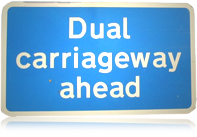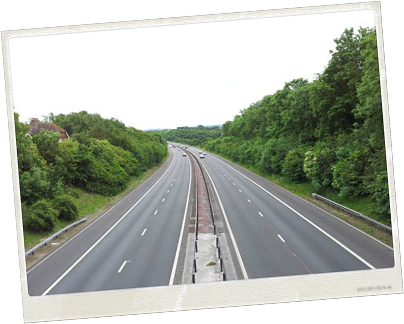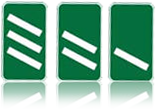But there are some big differences. On a dual carriageway, you can expect learner drivers, slow farm vehicles, right hand turns, traffic lights, roundabouts and even cyclists. You won't see any of those on a motorway!

Joining a dual carriageway
To enter onto a dual carriageway, you'll be joining on a slip road.This is used to accelerate to match the speed of vehicles on the dual carriageway and can vary in length. Be aware of the speed of vehicles on the dual carraigeway. Joining the dual carriageway too slowly could affect other drivers and be dangerous. Although, be careful as there might be slow moving or stationary vehicles on the dual carriageway that might be stuck in congestion.
Make sure that you check your mirrors, blind spot and signal to join. Don't cause other drivers to slow down or swerve. If it's busy, check that other drivers have noticed you wanting to join and slowly move onto the dual carriageway from the slip road once it's safe. Other drivers will normally notice you wanting to join and react by giving you space or changing lanes.

Driving on the dual carriageway.
Keep in the left lane unless overtaking. Get used to the speed before thinking about overtaking. On the far left is the hard shoulder, this is used in case of emergency and is a dangerous place to be.Only overtake if the vehicle in front of you is travelling slower than you. Give yourself plenty of time to overtake and make sure that it's safe and that you won't have to drive over the speed limit. Use your MSM routine, making sure to signal to other road users your intention. Move back to the left lane once you have finished overtaking. Don't turn back in too soon and take away the other vehicles stopping distance. Always remember to signal.
Moving back to the left lane when it's safe is important so that you don't cause congestion and annoy other drivers who might want to overtake you.

Exiting the dual carriageway.
You'll exit the dual carriageway normally on a slip road, but sometimes there isn't a slip road. If there is no slip road then turn left into the side road like you normally would.Turning right to exit a dual carriageway is a feature that you wouldn't get on a motorway and can be dangerous. If you are turning right across the dual carriageway to exit then be aware that oncoming cars might be driving faster than you are used to.
If there is a slip road, then look out for countdown marker signs that will indicate how far to the start of the slip road (300 yards, 200 yards and 100 yards). Be prepared and don't rush to exit. Slow down once you have turned onto the slip road and look out for a possible change in speed limit (which may feel slower than normal), a roundabout or traffic lights.
